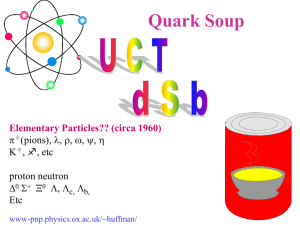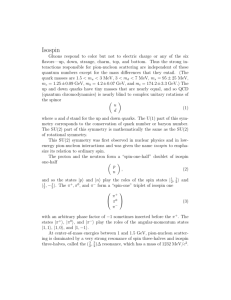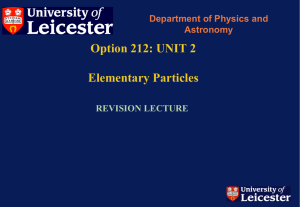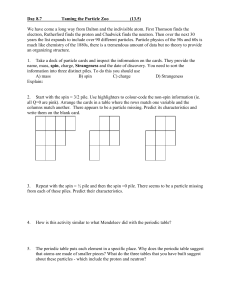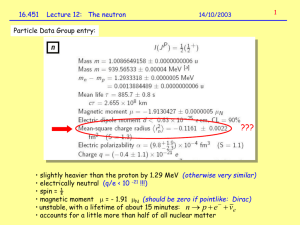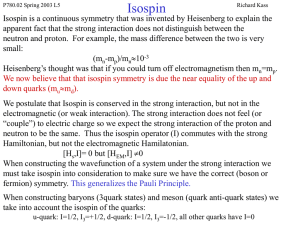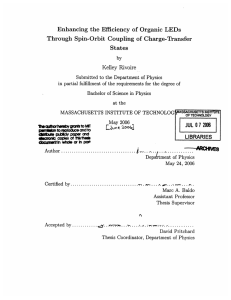Group-Symmetries and Quarks - USC Department of Physics
advertisement
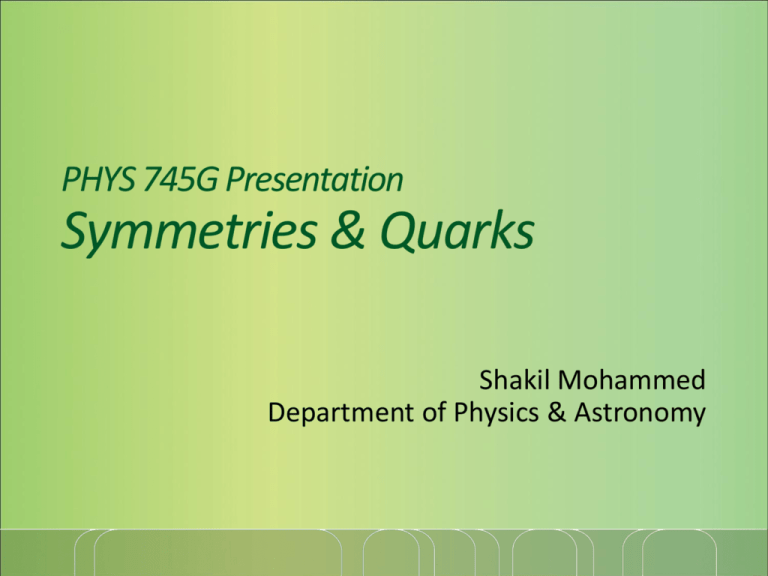
PHYS 745G Presentation Symmetries & Quarks Shakil Mohammed Department of Physics & Astronomy Overview A Brief Overview of Symmetries & Groups The SU(2) Group The SU(3) Group Quark-Antiquark States: Mesons Three Quark States: Baryons Magnetic Moments Symmetries in Physics Isospin: Quantum number related to the Strong Interactions For a two-nucleon system, the spin singlet and triplet states are: Similarly, each nucleon has an isospin, I = ½, with I3=± ½ for protons and neutrons. Then the spin states are: The Group SU(2) Generators Pauli Matrices The base states Pauli Matrices are Hermitian The 2×2 matrices known as U(2) and traceless 2×2 form a subgroup SU(2) in two dimension Combining representations: • Composite system from 2 systems having angular momentum jA and jB • Combined operator • With a basis, Where C = Clebsh-Gordan coefficients and M=mA+mB. The C’s are calculated by using Symbolically, For a third spin-1/2, SU(2) of Isospin • The nucleon having an internal degree of freedom with two allowed states – Isospin • Isospin generators satisfy, • Generators are denoted as Ii = ½ τi, where Isospin for Antiparticles • The antinucleaon states with operator C • Applying C to the state, • If we want to transform the antiparticle doublet the same way as particle doublet, then • A composite system of a nucleonantinucleon pair The Group SU(3) • The set of 3×3 matrices with detU = 1 for the group SU(3) • Fundamental representation of SU(3) is a triplet • The color charges of Quark R, G, B form a SU(3) symmetry group. They are denoted by λi, with i = 1,2,…,8. • The diagonal matrices are: With eigenvalues: Quark-Antiquark States: Mesons Hypercharge: Y = B + S Charge Qe: Q = I3 + Y/2 • For 3 flavors of Quarks, q = u, d, s – 9 possible combinations of Quark-Antiquark • Among 9 combinations – 8 states are in SU(3) Octet and 1 state in SU(3) singlet • The 8 states transform among themselves, but do not mix with singlet state The states uu*, dd*, ss* labeled A, B and C have I3 = Y = 0. •The singlet combination C = √1/3(uu*+dd*+ss*) • State A, a member of the isospin triplet (du*,A,-ud*) A= √1/2(uu*-dd*) • Isospin singlet state B (by requiring orthogonality to both A and C) B= √1/6(uu*+dd*-2ss*) • The excited states of mesons correspond to the observed meson states • Parity of Meson, P = -(-1)L • The particle-antiparticle conjugation operator C is given by, C = -(-1)S+1(-1)L = (-1)L+S • In each nonet of the meson, there are two isospin doublets Mesons of Spin 0 Mesons of Spin 1 Three Quark States: Baryons • There are 27 possible qqq combinations involved in the SU(3) decomposition • First, the two qq combinations arrange themselves into two SU(3) multiplets having 6 symmetric and 3 anti-symmetric states • Next, we add the 3rd Quark triplet such that, • For the pA part, pA = √1/2(ud-du)u • For the S part Δ = √1/3[uud+(ud+du)u] • The remaining part requires orthogonality and thus, pS = √1/6[(ud+du)u-2uud] For the case of Spins, • Baryon spin multiplets with S = 3/2, 1/2, 1/2 • Replacing u →↑ and d →↓we can have the spin multiplets, • Next, we combine the SU(3) flavor decomposition with SU(2) spin decomposition The spin ½ baryon octet The spin 3/2 baryon decuplet For the case of Color • The 3 possible values of color are R, G, B • The quarks form fundamental triplet of an SU(3) color symmetry • The color wavefunction of a baryon is, (qqq)col.singlet = √1/6(RGB-RBG+BRG-BGR+GBR- GRB) Example: Wavefunction of spin-up proton • In ground state, l=l’=0 for the qqq The parity in ground state = (-1)l+l’ • In 1st excited state, l=1, l’=0 or l=0, l’=1 •The first excited state contains (1+8+10) flavor multiplets of S = ½ baryons and octet of S = 3/2 baryons • The spins combine with L = 1 to give Multiplets 1, 8, 10 with JP=1/2- and JP=3/2Three octets with JP=1/2-,3/2-,5/2- Magnetic Moments • The magnetic moment operator is given as • Where, the magnetic moment for Quark is • For proton (in the non-relativistic approx.)
